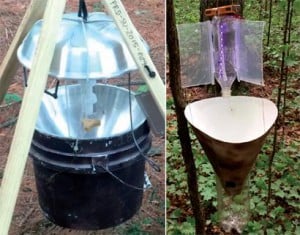Share this article
Field note: A cheaper way to collect moths
Assistant professor at Michigan State University Peter White ordered moth traps for his undergraduate students working on a research project, but there was a delay in shipping.
So, instead of waiting for the traps to arrive, White decided to figure out a way to make the traps himself. With his students’ help, White constructed a moth trap using LED light strips, rechargeable nine-volt batteries, a milk jug, a soda bottle, poster board tape, glue, Velcro and twine.

Commercially made 12-volt mercury vapor black light traps such as the one on the left are heavy and cost between $200 and $500 apiece. The LED light trap on the right is lighter and costs just under $30. ©Entomological Society of America
Mirroring the design of the commercially available mercury vapor black light traps — or MVTs — White, lead author of a recent study published in the Journal of Insect Science, used LED lights that attract the insects, which then fall into a funnel that leads to a collection bucket at the bottom. MVTs require car or motorcycle batteries to power them, White said, adding that these batteries are heavy and expensive. “The motorcycle battery lasts a few nights which is fine unless you’re going to remote areas,” he said. However, the LEDs could be powered by smaller rechargeable batteries.
When the commercially available vapor bulbs arrived, White’s students then tested out how they performed compared to the ones White and his students constructed. The team picked a woodlot at Michigan State University and set up both light traps at either end of the woodlot. They then collected data on the moths for 12 nights from June to July and kept track of the abundance and species richness of moths caught by each device.
They found that the cheaper, self-constructed light trap collected about 80 to 85 percent of the diversity as the commercially available trap and was 50 to 60 percent as effective in abundance. While the LED trap was not as effective as the MVT trap, the LED trap is only about one-eighth the cost. It’s just under $30 apiece and the commercially available ones are $200 or more, according to White.
White added that if researchers need 10 or 15 traps, they can use the LED design and complete this part of the project spending only $300 compared with $2,000 to $3,000 for the commercially available ones.
White said for people looking to collect moths without breaking the bank or for researchers on a limited budget, this device is a good alternative for surveying the types of moths in the area. He’s also working to introduce the light traps to the grade-school classroom. “We’re working on a project with sixth grade science students and getting [the traps] into their hands,” he said. They will collect moths for their science classes and study where moth populations live.
Header Image: Celery Looper Moth. ©Andy Reago & Chrissy McClarren








